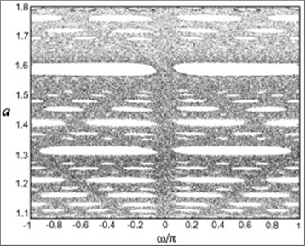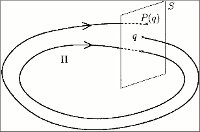Low-energy Inter-moon Transfers via Resonant Gravity Assists

A very challenging part in the design of a planetary moon tour, such as a multi-moon orbiter in the Jupiter system, is the orbital transfer from one planetary moon to another for low-energy transfer. Multiple gravity assists by moons could be used in conjunction with ballistic capture to drastically decrease fuel usage. In planetary systems, the strong dependence on the three-body regimes of motion precludes the use of a patched conic approach. Instead, some recent approaches employ patched three-body model to enable multiple “resonant-hopping” gravity assists.
Poincare Maps for Dynamical Systems

Many natural phenomena found in various area, such as orbital mechanics, fluid dynamics or quantum mechanics, can be described in terms of Hamiltonian dynamics. Multi-dimensional Hamiltonian systems often exhibit chaotic behavior, which makes their analysis difficult. The use of surfaces of section, such as Poincaré return map, is commonly employed to get insight into the phase space of dynamical systems, which present both, regular and chaotic behavior. A Poincare surface of section can be interpreted as a discrete dynamical system with a state space that is one dimension smaller than the original continuous dynamical system. On the map, a periodic trajectory becomes a point, while a non-periodic trajectory is represented by a set of points. One of the advantages of the Poincare map lies in its power as a visualization tool. Such a map reduces the order of the problem, condensing quantities of information into a lower-dimensional image. Poincare maps reveal, at a glance, regions of well-ordered behavior, despite the chaotic nature of the underlying problem.
The Keplerian Map for Resonant Transfers Between Jovian’s Moons
Many different maps can be generated and useful for several applications. Besides the traditional Poincare map, other types of maps are the Periapsis Poincare maps or Keplerian maps, which display the semi-major axis of each trajectory as it evolves over time as a function of the initial periapsis angle. Keplerian maps offer some advantages compared to the traditional Poincaré maps: The geometry and structures of Keplerian maps are relatively straight forward to detect. These maps are composed of resonant structures, which govern transport from one orbit to another. The random scattered points correspond to chaotic motion whereas blank 'holes' represent stable resonant islands. For every semi-major axis value, corresponding to a K:L resonance, there is a band of L islands. The Keplerian maps are typically generated via integration of the full dynamics in the circular restricted-three body model, using a Poincare surface of section at periapsis. For orbits nearby Keplerian energies, the dynamics of the PCR3BP can be approximated via a symplectic twist maps, which capture well the dynamics of the full equations of motion. Using symplectic maps as an approximation of the full dynamics considerably reduce the computation and enable the design of quick algorithms for low-energy transfers and optimization procedures.